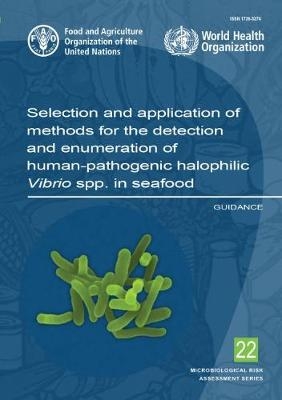
Selection and application of methods for the detection and enumeration of human-pathogenic Halophilic Vibrio spp. in seafood
guidance
Seiten
2017
Food & Agriculture Organization of the United Nations (FAO) (Verlag)
978-92-5-109354-2 (ISBN)
Food & Agriculture Organization of the United Nations (FAO) (Verlag)
978-92-5-109354-2 (ISBN)
Provides guidance on the most appropriate methods for generating data on Vibrio spp., a foodborne pathogen that affects seafood. A range of potential data collection methods are presented, from culture-based to molecular, and the publication proposes means of selecting the most appropriate method for specific end uses.
This publication provides guidance on the most appropriate methods for generating data on Vibrio spp., a foodborne pathogen that affects seafood. One of the challenges in undertaking global risk assessments for halophilic Vibrio spp. has been identifying datasets that are comparable and representative of the range of conditions in which halophilic Vibrio spp. grow and become a problem for seafood safety. A range of potential data collection methods are presented, from culture-based to molecular, and the publication proposes means of selecting the most appropriate method for specific end uses, for example harvest area monitoring, post-harvest process verification, end product monitoring, or outbreak investigation. Data requirements that could support national and regional risk assessments are also addressed. This volume and others in this series will be useful for seafood safety risk assessors and risk managers, governments and regulatory agencies, seafood producers and processers, laboratories and others with an interest in Vibrio spp. in seafood.
This publication provides guidance on the most appropriate methods for generating data on Vibrio spp., a foodborne pathogen that affects seafood. One of the challenges in undertaking global risk assessments for halophilic Vibrio spp. has been identifying datasets that are comparable and representative of the range of conditions in which halophilic Vibrio spp. grow and become a problem for seafood safety. A range of potential data collection methods are presented, from culture-based to molecular, and the publication proposes means of selecting the most appropriate method for specific end uses, for example harvest area monitoring, post-harvest process verification, end product monitoring, or outbreak investigation. Data requirements that could support national and regional risk assessments are also addressed. This volume and others in this series will be useful for seafood safety risk assessors and risk managers, governments and regulatory agencies, seafood producers and processers, laboratories and others with an interest in Vibrio spp. in seafood.
Founded in 1945, the Food and Agriculture Organization (FAO) leads international efforts to defeat hunger. Serving both developed and developing countries, FAO provides a neutral forum where all nations meet as equals to negotiate agreements and debate policy. The Organization publishes authoritative publications on agriculture, fisheries, forestry and nutrition.
| Erscheinungsdatum | 12.08.2017 |
|---|---|
| Reihe/Serie | Microbiological risk assessment series ; 22 |
| Zusatzinfo | ill. |
| Verlagsort | Rome |
| Sprache | englisch |
| Themenwelt | Technik ► Lebensmitteltechnologie |
| Weitere Fachgebiete ► Land- / Forstwirtschaft / Fischerei | |
| ISBN-10 | 92-5-109354-7 / 9251093547 |
| ISBN-13 | 978-92-5-109354-2 / 9789251093542 |
| Zustand | Neuware |
| Haben Sie eine Frage zum Produkt? |
Mehr entdecken
aus dem Bereich
aus dem Bereich
Technologie, Chemie, Mikrobiologie, Analytik, Bedeutung, Recht
Buch | Hardcover (2023)
Verlag Eugen Ulmer
140,00 €


